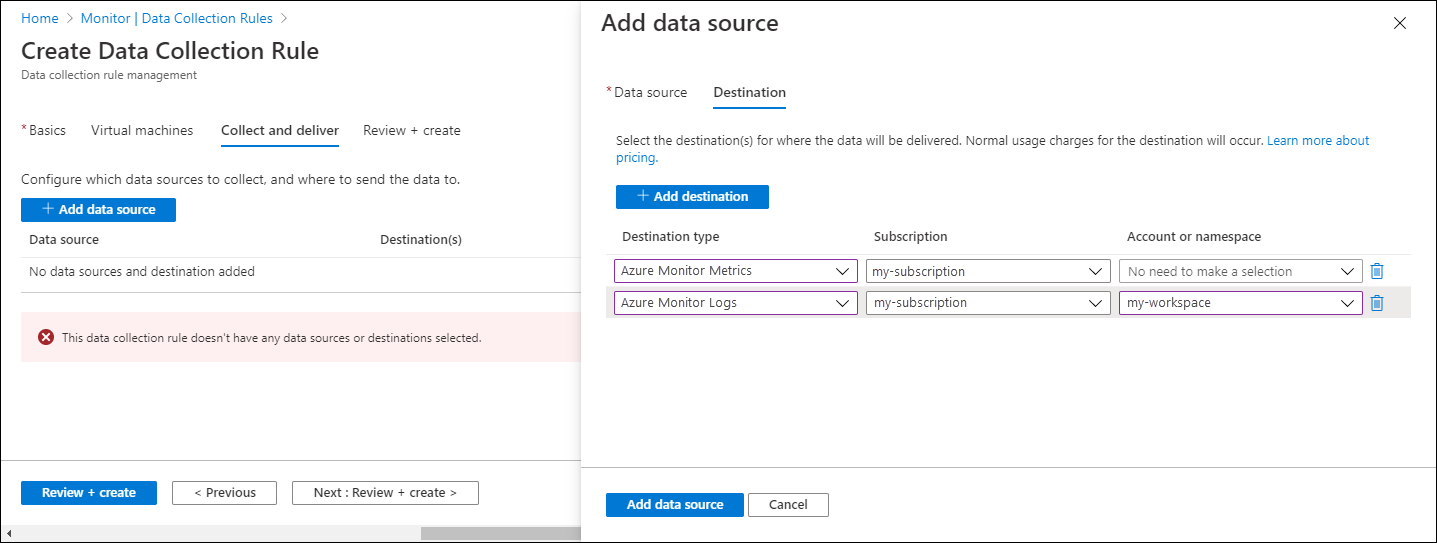Samla in prestandaräknare med Azure Monitor Agent
Prestandaräknare är en av de datakällor som används i en datainsamlingsregel (DCR). Information om hur du skapar DCR finns i Samla in data med Azure Monitor Agent. Den här artikeln innehåller mer information om datakällans typ av Windows-händelser.
Prestandaräknare ger insikter om prestanda för maskinvarukomponenter, operativsystem och program. Azure Monitor Agent kan samla in prestandaräknare från Windows- och Linux-datorer med jämna mellanrum för analys i nära realtid.
Förutsättningar
- Om du ska skicka prestandadata till en Log Analytics-arbetsyta måste du ha skapat en där du har minst deltagarbehörighet.
- Antingen en ny eller befintlig DCR som beskrivs i Samla in data med Azure Monitor Agent.
Konfigurera datakälla för prestandaräknare
Skapa en datainsamlingsregel enligt beskrivningen i Samla in data med Azure Monitor Agent. I steget Samla in och leverera väljer du Prestandaräknare i listrutan Datakällatyp .
För prestandaräknare väljer du från en fördefinierad uppsättning objekt och deras samplingshastighet.
Välj Anpassad för att ange en XPath för att samla in prestandaräknare som inte är tillgängliga som standard. Använd formatet \PerfObject(ParentInstance/ObjectInstance#InstanceIndex)\Counter. Om räknarnamnet innehåller ett et-tecken (&) ersätter du det med &. Exempel: \Memory\Free & Zero Page List Bytes Du kan visa standardräknare för exempel.
Varning
Var försiktig när du manuellt definierar räknare för DCR:er som är associerade med både Windows- och Linux-datorer, eftersom vissa räknarnamn i Windows- och Linux-stil kan matchas till samma mått och orsaka duplicerande samling. Om du till exempel anger både \LogicalDisk(*)\Disk Transfers/sec och Logical Disk(*)\Disk Transfers/sec i samma DCR kommer måttet Disköverföringar att rapporteras två gånger per samplingsperiod. Det här beteendet kan undvikas genom att inte samla in prestandaräknare i otypade domänkontrollanter. se till att räknare i Windows-stil endast anges i Windows-typ-DCR och endast associeras med Windows-datorer och vice versa för räknare i Linux-stil.
Kommentar
För närvarande kan Microsoft.HybridCompute-resurser (Azure Arc-aktiverade servrar) inte visas i Metrics Explorer (Azure Portal UX), men de kan hämtas via METRICS REST API (Metric Namespaces - List, Metric Definitions - List och Metrics - List).
Destinationer
Prestandaräknare kan skickas till följande platser.
| Mål | Tabell/namnområde |
|---|---|
| Log Analytics-arbetsyta | Perf (se Referens för Azure Monitor-loggar) |
| Azure Monitor-statistik | Windows: Virtuell datorgäst Linux: azure.vm.linux.guestmetrics |
Kommentar
I Linux stöds azure monitor-mått som enda mål i v1.10.9.0 eller senare.
Logga frågor med prestandaposter
Följande frågor är exempel för att hämta prestandaposter.
Alla prestandadata från en viss dator
Perf
| where Computer == "MyComputer"
Genomsnittlig CPU-användning på alla datorer
Perf
| where ObjectName == "Processor" and CounterName == "% Processor Time" and InstanceName == "_Total"
| summarize AVGCPU = avg(CounterValue) by Computer
Timgenomsnitt, minsta, högsta och 75-percentil cpu-användning för en viss dator
Perf
| where CounterName == "% Processor Time" and InstanceName == "_Total" and Computer == "MyComputer"
| summarize ["min(CounterValue)"] = min(CounterValue), ["avg(CounterValue)"] = avg(CounterValue), ["percentile75(CounterValue)"] = percentile(CounterValue, 75), ["max(CounterValue)"] = max(CounterValue) by bin(TimeGenerated, 1h), Computer
Kommentar
Ytterligare frågeexempel finns i Frågor för tabellen Perf.
Nästa steg
- Samla in textloggar med hjälp av Azure Monitor Agent.
- Läs mer om Azure Monitor Agent.
- Läs mer om regler för datainsamling.


